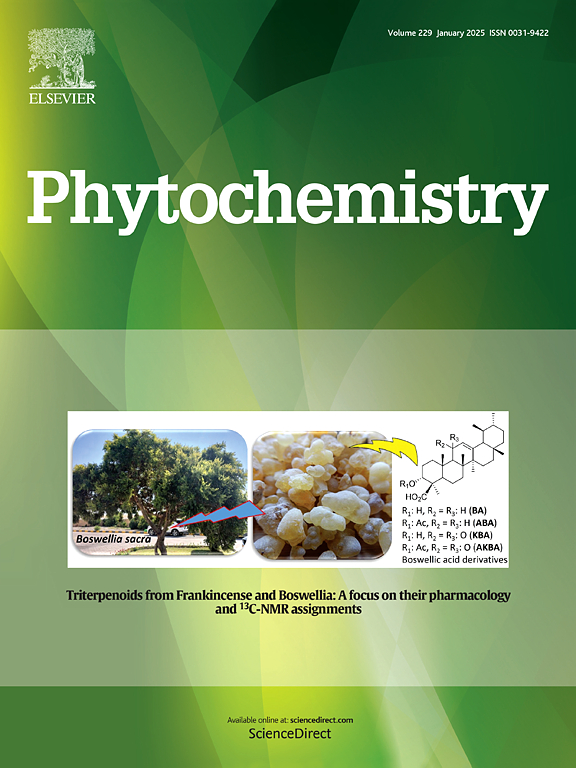枸杞谷胱甘肽转移酶增强氢过氧化物酶活性和配体素功能的功能表征和定向进化。
IF 3.4
2区 生物学
Q2 BIOCHEMISTRY & MOLECULAR BIOLOGY
引用次数: 0
摘要
Tau类谷胱甘肽转移酶(GSTUs)通过促进谷胱甘肽(GSH)对多种亲电外源物的亲核攻击,在植物防御中发挥重要作用。除了偶联活性外,这些酶还具有氢过氧化物酶的功能,使有害的有机氢过氧化物解毒成反应性较低的醇。在本研究中,我们通过计算同源性筛选,鉴定了三种密切相关的cizer arietinum (CaGSTUs) GST同工酶(96-98%序列同源性)。我们克隆了编码这些gst的全长cdna,在大肠杆菌中重组产生,并纯化用于功能鉴定。利用模型底物异丙苯氢过氧化物(CuOOH)和1-氯-2,4-二硝基苯(CDNB)对酶动力学进行了评价,结果表明CaGSTU1-1具有优异的氢过氧化物酶活性和热稳定性。基于这些特性,我们选择了CaGSTU1-1作为亲本支架,利用同源的甘氨酸max同工酶GmGSTU4-4通过DNA重组进行定向进化。对生成的嵌合文库进行筛选,鉴定出一个新的变体CaGmGSTU,其对两种底物的催化转化率和效率提高了四倍。此外,CaGmGSTU表现出改变的配体结合特性,包括对选定农药的亲和力增加。结构建模和粘度依赖动力学表明,这些增强主要是由酶灵活性的变化驱动的。考虑到氢过氧化物和相关污染物的广泛毒性,CaGmGSTU代表了环境和农业生物技术解毒应用的有前途的工具。本文章由计算机程序翻译,如有差异,请以英文原文为准。

Functional characterization and directed evolution of Cicer arietinum glutathione transferases for enhanced hydroperoxidase activity and ligandin function
Tau class glutathione transferases (GSTUs) play essential roles in plant defense by facilitating the nucleophilic attack of glutathione (GSH) to a wide range of electrophilic xenobiotics. In addition to their conjugating activity, these enzymes possess hydroperoxidase function, enabling the detoxification of harmful organic hydroperoxides into less reactive alcohols. In this study, we identified three closely related GST isoenzymes (96–98 % sequence identity) from Cicer arietinum (CaGSTUs) through computational homology screening. Full-length cDNAs encoding these GSTs were cloned, recombinantly produced in E. coli, and purified for functional characterization. Enzyme kinetics were evaluated using model substrates, cumene hydroperoxide (CuOOH) and 1-chloro-2,4-dinitrobenzene (CDNB), revealing that CaGSTU1-1 displayed superior hydroperoxidase activity and thermal stability. Based on these properties, CaGSTU1-1 was selected as the parental scaffold for directed evolution via DNA shuffling, using the homologous Glycine max isoenzyme GmGSTU4-4. Screening of the generated chimeric library resulted in the identification of a new variant, CaGmGSTU, which demonstrated a fourfold enhancement in catalytic turnover and efficiency toward both substrates. Additionally, CaGmGSTU exhibited altered ligand-binding characteristics, including increased affinity for selected pesticides. Structural modeling and viscosity-dependence kinetics indicated that these enhancements were primarily driven by changes in enzyme flexibility. Given the widespread toxicity of hydroperoxides and related pollutants, CaGmGSTU represents a promising tool for detoxification applications in environmental and agricultural biotechnology.
求助全文
通过发布文献求助,成功后即可免费获取论文全文。
去求助
来源期刊

Phytochemistry
生物-植物科学
CiteScore
6.40
自引率
7.90%
发文量
443
审稿时长
39 days
期刊介绍:
Phytochemistry is a leading international journal publishing studies of plant chemistry, biochemistry, molecular biology and genetics, structure and bioactivities of phytochemicals, including ''-omics'' and bioinformatics/computational biology approaches. Phytochemistry is a primary source for papers dealing with phytochemicals, especially reports concerning their biosynthesis, regulation, and biological properties both in planta and as bioactive principles. Articles are published online as soon as possible as Articles-in-Press and in 12 volumes per year. Occasional topic-focussed special issues are published composed of papers from invited authors.
 求助内容:
求助内容: 应助结果提醒方式:
应助结果提醒方式:


